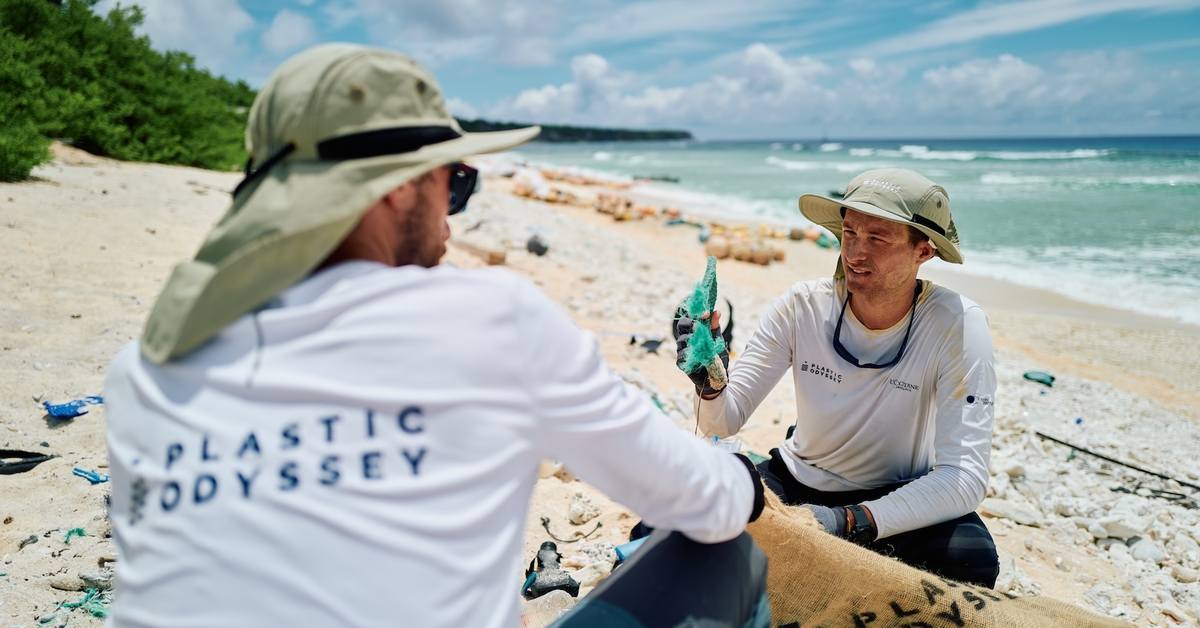
This remote island in the Pacific Ocean, known as one of the most polluted places on Earth, was once considered impossible to clean. In 2019, an expedition attempted to rid Henderson Atoll of its pollution, collecting six tons of waste from one of its beaches. However, the surrounding coral reef doomed the mission to failure.
Five years later, a team from the organization Plastic Odyssey took on the challenge again—this time successfully. Creative and determined, they even used parachutes to tow rafts carrying waste. This delicate yet spectacular task is the focus of the documentary Plastic Odyssey – Mission Pacifique, broadcast on Canal+.
This achievement adds another milestone to the organization’s work. Since 2022, its laboratory ship has been sailing the oceans to « discover, document, and share concrete solutions to end the plastic waste crisis. » While in Paris last December, Plastic Odyssey co-founder Simon Bernard spoke with Usbek & Rica about the future of the fight against plastic pollution.
« Wanting to clean the oceans is utopian, » your colleague Alexandre Dechelotte told Usbek & Rica in 2018. What was the goal of the Henderson Island cleanup mission?
Simon Bernard:
In one week, with a team of ten people, we cleaned up an entire UNESCO site with one of the highest concentrations of plastic waste in the world. This was a slight departure from our usual work, but we felt it was important to restore such sites, which serve as biodiversity sanctuaries. There are about fifty such places on Earth. It’s a shame to leave them in such a state.
We found that the plastic concentration on these islands is 400 times higher than in the so-called « Great Pacific Garbage Patch. » Scientific studies show that these islands act as natural nets, trapping and storing marine pollution.
Furthermore, to stop pollution, we need to understand where it comes from. Right now, we don’t fully know. On Henderson Island, we estimate that 90 to 100% of the waste we collected came from fishing: about one-third nets, one-third buoys, and one-third rigid plastics, likely from fishing crates. We will soon publish a more detailed scientific study on the subject.
Another ocean cleanup project, The Ocean Cleanup, claims that the Great Pacific Garbage Patch could be cleaned by 2034. Do you believe that?
Simon Bernard:
Yes, that seems credible because, in reality, there isn’t that much plastic in the garbage patch. It holds the equivalent of the amount of plastic that enters the ocean every few days—at a rate of 19 tons per minute (The Ocean Cleanup estimates that over 100,000 tons of plastic are in the patch).
The organization claims it would take $7.5 billion to clean it up. In contrast, we calculated that funding enough micro-recycling plants to halt plastic pollution—about 20 million tons of plastic entering the ocean annually—would cost between €7 and €10 billion. With that sum, we could stop the problem at its source. If we need to start somewhere, it should be there. All solutions help, but unfortunately, money is limited.
If we want to remove plastic from the ocean, we should focus on the areas where it is most concentrated. Cleaning the natural nets formed by coastlines and islands seems much more effective than dragging nets through ocean zones where plastic is more dispersed.
What about micro- and nanoplastics? Do you have any ideas for tackling this issue?
Simon Bernard:
Microplastics account for 10% of plastic waste by weight (but 90% in number). When it’s micro-sized, we can still filter it, but at the nano level, the particles are so small they can even pass through the brain’s protective barriers. Some solutions are being considered to remove these particles, but to what end? The ocean is full of plankton and marine life—we can’t filter the entire ocean.
In terms of priorities, microplastics should be the last concern because they are the most complex and expensive to remove. First, we should eliminate macro-waste. If we ever get to it, then we can consider filtering the entire ocean and figuring out how to separate plankton from plastic.
With the Plastic Odyssey expedition, you have deployed micro-recycling plants in several countries, capable of processing between 200 and 600 tons of waste per year. Could this low-tech model be scaled up? How does it compare to large recycling plants?
Simon Bernard:
Yes, I think it’s complementary. In the countries we visit, large recycling plants are rare because transporting waste isn’t profitable. Unlike aluminum or copper, collecting and transporting plastic to a large plant is too costly. Few do it, and when they do, it’s mostly for PET water bottles. Large recycling companies like Veolia only handle very specific waste streams. There is also informal recycling, but it doesn’t cover all plastics.
Our micro-plants focus on low-value plastics that would otherwise never be collected—bags, plastic films, etc. The idea is that decentralized recycling reduces transportation costs by bringing the plant to the source of waste production.
Our model is a franchise: we build the machines, secure funding from banks and clients, organize waste collection, and then deploy the plants. The trained entrepreneurs only need to operate them. Our goal is to have around a hundred plants within three to four years.
What happens to the recycled waste?
Simon Bernard:
We can make various products—planks for furniture, pallets, benches, trash bins… We’re still in the early stages and are experimenting. We recently created a catalog of finished products. The challenge is finding items that can be sold in large quantities and won’t turn into waste again.
Could this model work in France?
Simon Bernard:
There are already similar initiatives. Le Pavé, for instance, is fantastic—they made the Olympic podiums from recycled plastic. There are about ten companies in France operating in this sector. But since wages are higher, they need to produce high-value, designer, and expensive products to be profitable.
The Plastic Odyssey model is better suited to low-income countries, where recycling creates jobs. In Senegal, 50% of young people are unemployed. These activities have a real economic impact. The ten plants we are setting up there will create 200 direct jobs, plus many more in waste collection, product sales, etc.
Will plastic recycling become economically viable in the future?
Simon Bernard:
Our goal is for these plants to break even—they aren’t profitable yet. You’ll never get rich recycling plastic, but the aim is to be financially self-sufficient so we can scale up without relying on subsidies. We need a sustainable economic model that creates jobs, recycles plastic, and potentially generates carbon credits (for plastic that would otherwise be burned in open dumps).
The first global treaty against plastic pollution failed in December. Should we stop relying on diplomacy to solve the problem?
Simon Bernard:
Everyone knew it would be a failure, which is why we didn’t attend. We prefer concrete, fast, and effective actions. We’re not much into advocacy, endless discussions, or « should do » speeches—they frustrate us. Look at COP21—it was hailed as a great success, but ten years later, it hasn’t led to much. On plastic pollution, we’re still far from achieving a Paris Agreement-like breakthrough.
Are you in contact with activist groups to advance the fight against plastic pollution?
Simon Bernard:
Not really, because, in reality, it’s energy wasted on something that doesn’t accomplish much. In most countries we’ve visited, we’ve met ministers and government officials. We’ve realized that in almost every country… [Interview continues]

